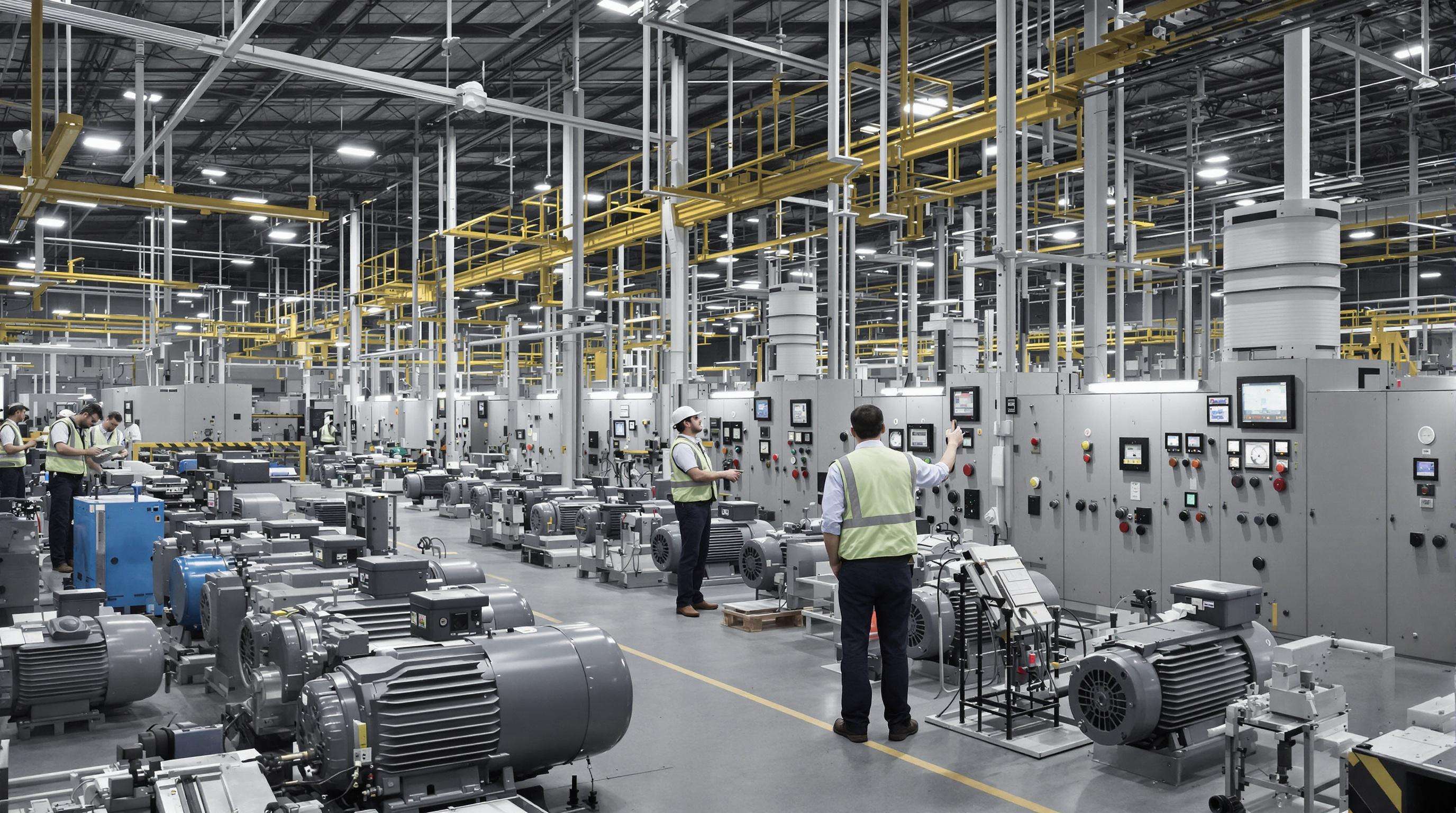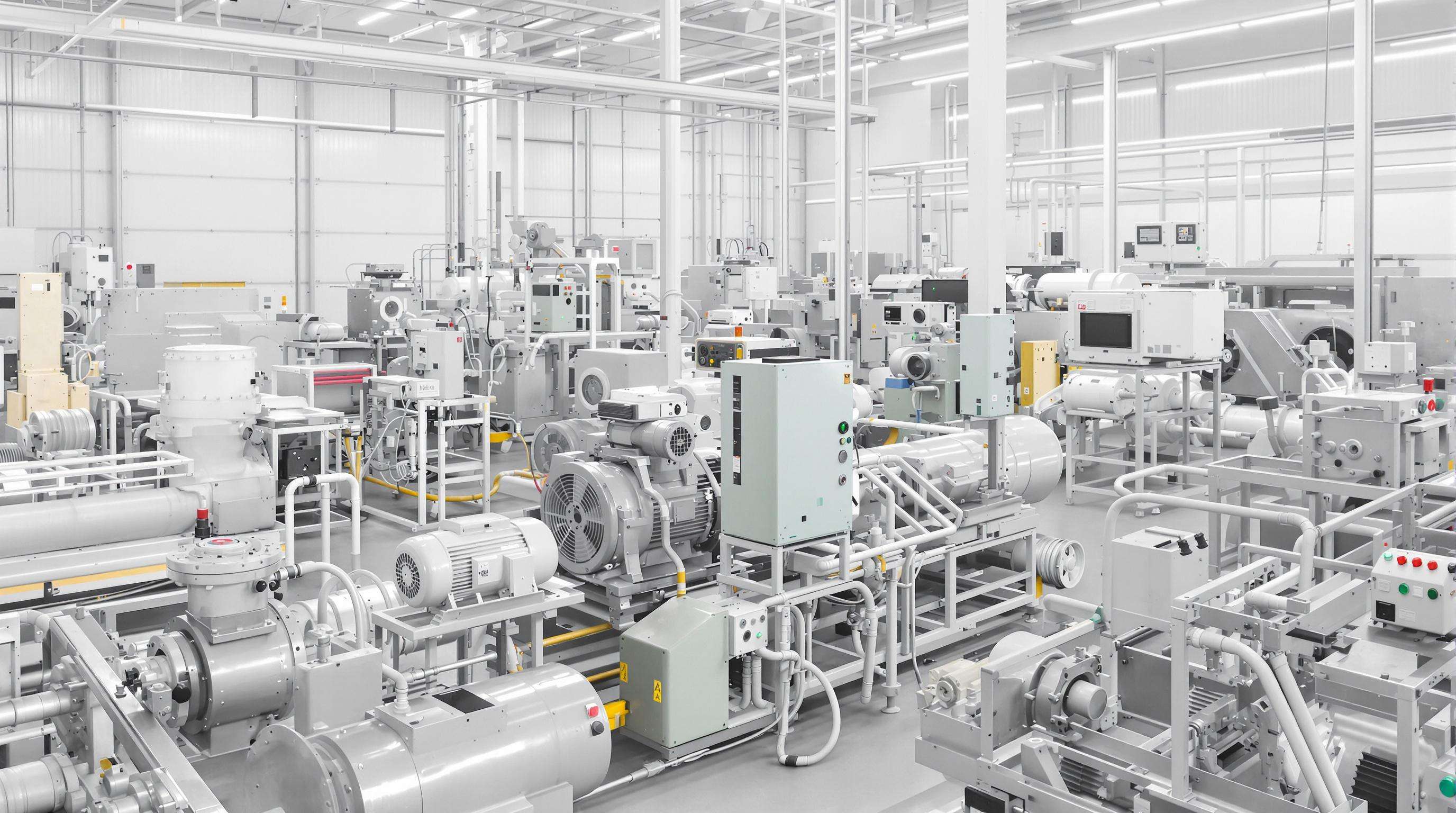اینورترهای صنعتی، یا درایوهای فرکانس متغیر که اغلب به آنها اینورتر میگویند، به این صورت کار میکنند که میزان برقی که به موتورها میرسد را بر اساس نیاز لحظهای تغییر میدهند. سیستمهای قدیمی با سرعت ثابت همیشه با حداکثر توان کار میکنند و این باعث هدر رفتن زیادی انرژی میشود، خصوصاً زمانی که کارهایی که نیاز به توان خروجی حداکثر ندارند. این اتلاف انرژی ناشی از روشهای قدیمی، طبق گزارش Plant Engineering در سال گذشته، حدود ۳۰ تا ۵۰ درصد از کل اتلاف انرژی در تجهیزاتی مانند پمپها و کمپرسورها را تشکیل میدهد. امروزه شرکتهای بزرگ تولیدکننده، ویژگیهای هوشمندی را در درایوهای خود پیادهسازی کردهاند که ضمن حفظ میزان مناسب نیرو، مصرف برق کلی را کاهش میدهند. برای کارخانههایی که به دنبال کاهش هزینههای انرژی هستند، استفاده از موتورهای ناکارآمد دیگر گزینهای عملی محسوب نمیشود.
مشکل موتورهای قدیمی این است که بدون توجه به نیاز واقعی، همواره با حداکثر توان کار میکنند. برای مثال یک نوار نقاله را در نظر بگیرید. وقتی فقط در حال حرکت دادن اشیاء سبک است، کاهش سرعت تقریباً ۲۰ درصدی با استفاده از اینورتر در واقع موجب صرفهجویی تقریبی ۴۰ درصدی در مصرف انرژی میشود. این امر به دلیل نحوه عملکرد مصرف انرژی در این دستگاهها و تبعیت از چیزی به نام قانون مکعب است. روشهای سنتی مانند ترمزهای مکانیکی یا شیرهای کنترل، موجب هدررفت زیادی از انرژی از طریق محدود کردن جریان میشوند. با این حال، سیستمهای جدیدتر هوشمندانهتر شدهاند. این سیستمها از فناوری ترمز بازیابیکننده استفاده میکنند که هنگام کاهش سرعت تجهیزات، انرژی اضافی را به شبکه برق بازمیگردانند. این کار نه تنها هزینهها را کاهش میدهد، بلکه عملیات صنعتی را در مجموع بسیار کارآمدتر میکند.
اینورترها به طور مداوم نیازهای بار را از طریق حسگرها و در زمان واقعی خروجی سهفاز را تنظیم میکنند. مزایای فنی کلیدی شامل:

اینورترهای صنعتی باعث کاهش هدر رفتن انرژی میشوند زیرا به اپراتورها این امکان را میدهند تا سرعت موتورها را به دقت کنترل کنند. بر اساس گزارش سازمان انرژی بینالمللی در سال 2023، تحقیقات نشان میدهد که درایوهای فرکانس متغیر معمولاً در هزینههای انرژی برای پمپها و فنها بین 38 تا 52 درصد صرفهجویی ایجاد میکنند. به عنوان مثال، یک موتور استاندارد 50 اسب بخاری را در نظر بگیرید که در حدود 80 درصد ظرفیت کار میکند. اگر این موتور 20 درصد کندتر از حالت عادی کار کند، در واقع میتواند هر سال حدود هفت هزار و دویست دلار صرفهجویی کند، به شرطی که بهرهوری واقعی این سیستمها را در نظر بگیریم. دلیل این صرفهجوییهای قابل توجه، رابطه مکعبی بین سرعت موتور و مصرف انرژی است. وقتی کسی سرعت یک بار گریز از مرکز را نصف کند، مصرف انرژی به میزان قابل توجهی تقریباً 87.5 درصد کاهش مییابد. به همین دلیل است که بسیاری از تولیدکنندگان به سمت استفاده از این فناوریها حرکت میکنند تا هزینههای خود را کاهش دهند و در عین حال مسئولیتپذیری بیشتری نسبت به محیط زیست از خود نشان دهند.
یک کارخانه نساجی در جنوب شرق آسیا پس از نصب مجدد 112 موتور با استفاده از اینورترهای صنعتی، صرفهجویی قابل توجهی داشت:
| METRIC | قبل از نصب | پس از نصب | کاهش |
|---|---|---|---|
| مصرف انرژی | 2.4 گیگاوات ساعت/ماه | 1.5 گیگاوات ساعت/ماه | 37.5% |
| هزینههای ماهانه برق | $192,000 | $120,000 | $72,000 |
| مدت زمان کارکرد موتور | 24/7 | 14 ساعت در روز (میانگین) | 40% |
پروژه بازگشت سرمایه را در مدت 11 ماه در حالی که خروجی تولید را از طریق کنترل بهینه موتور حفظ میکند.
اگرچه اکثر اینورترهای مدرن حداقل استانداردهای بهرهوری را برآورده میکنند، عملکرد دنیای واقعی به تطبیق مناسب بار و کاهش هارمونیکها بستگی دارد. یک تحلیل از 47 سایت صنعتی در سال 2022 نشان داد: تطبیق بار و کاهش هارمونیک. یک تحلیل از 47 سایت صنعتی در سال 2022 نشان داد:
دادههای آزمایش توسط طرف سوم نشان میدهد که یک شکاف 19 درصدی در عملکرد بین ادعاهای آزمایشگاهی و عملیات دنیای واقعی در محیطهای با ارتعاش شدید وجود دارد. برای تضمین نتایج بهینه، مراکز باید استقرار اینورتر را با ممیزی کیفیت توان و بازرسیهای تصویربرداری حرارتی همراه کنند—مراحلی که اغلب در خریدهای عمده نادیده گرفته میشوند.

اینورترهای صنعتی کنترل بهتری بر روی سرعت پمپها و فنها فراهم میکنند، چیزی که سالهاست مشکلی محسوب میشود، چون این سیستمها معمولاً همیشه با حداکثر سرعت کار میکنند و انرژی زیادی را هدر میدهند. وقتی خروجی موتور متناسب با نیاز واقعی تنظیم شود، بسیاری از واحدها شاهد کاهش ۲۵ تا حتی ۵۰ درصدی صورتحساب انرژی خود خواهند بود. به عنوان مثالی میتوان به پمپهای گردش آب اشاره کرد. این پمپها وقتی با درایوهای فرکانس متغیر تجهیز شده باشند، در شرایطی که تقاضای آب کمتر است واقعاً کندتر کار میکنند، که این امر مصرف برق را کاهش میدهد، بدون آنکه میزان دبی لازم برای عملکرد مناسب را به هم بزند.
نوارهای نقاله اغلب بارهای خالی را با سرعتهای ثابتی حرکت میدهند، در حالی که دستگاههای فشردهساز در زمان تولید کم، بدون نیاز کار میکنند. اینورترها با ایجاد تغییرات سرعت متناسب با بار، این ناکارآمدیها را از بین میبرند. یک کارخانه بستهبندی پس از نصب مجدد موتورهای خود با اینورترها که باعث حذف چرخههای کاری بدون بار شد، هزینههای انرژی دستگاههای فشردهساز خود را ۳۸٪ کاهش داد.
تولیدکنندگان به طور فزایندهای مبدلها را با سیستمهای مدیریت انرژی متصل به اینترنت ترکیب میکنند تا عملیات خود را در سراسر کارخانههایشان بهینه کنند. بر اساس گزارشهای اخیر صنعتی در زمینه تولید هوشمند، کارخانههایی که درایوهای فرکانس متغیر را با نرمافزارهای نگهداری پیشبینانه ادغام میکنند، معمولاً هزینههای انرژی موتور را سالانه حدود ۱۸ تا ۲۲ درصد کاهش میدهند. قدرت واقعی زمانی حاصل میشود که این سیستمها در کنار تجهیزات مختلفی مانند پمپها، نوارهای نقاله و سیستمهای گرمایشی با هم کار کنند. آنچه به عنوان صرفهجویی کوچک در اجزای جداگانه آغاز میشود، در نهایت به بهبود قابل توجهی در کارایی کلی کارخانه و تأثیرات زیستمحیطی منجر میشود.
انتخاب اینورتر مؤثر نیازمند هماهنگی مشخصات فنی با ویژگیهای بار موتور و اهداف بلندمدت انرژی است. سیستمهای نادرست پیکربندی شده، تا 30٪ از هدررفت انرژی قابل جلوگیری در کاربردهای موتورهای دیزلی را تشکیل میدهند (موسسه پونمون، 2023)، که باعث میشود تطبیق دقیق برای موفقیت در گسترش گسترده ضروری باشد.
موتورهای صنعتی به دو دسته اصلی تقسیم میشوند: بارهای گشتاور ثابت (نوار نقالهها، کمپرسورها) و بارهای گشتاور متغیر (پمپها، فنها). کاربردهای گشتاور ثابت نیازمند اینورترهایی با ظرفیت بار اضافه قوی (150٪ برای 60 ثانیه) هستند، در حالی که سیستمهای گشتاور متغیر از منحنیهای کنترل V/f درجه دومی بهره میبرند که مصرف انرژی را در بارهای جزئی کاهش میدهند. تطبیق نادرست میتواند منجر به اتلاف کارایی 15 تا 25 درصدی شود.
اینورترهای بزرگتر از حد لازم که در زیر ۴۰٪ ظرفیت کار میکنند، ۳ تا ۸٪ از توان ورودی را از دست میدهند و این اتلاف به دلیل تلفات سوئیچینگ است، در حالی که اینورترهای کوچکتر از حد لازم موتورها را مجبور به کار در مناطق بار اضافی ناکارآمد میکنند. پنجره بهینه اندازهگیری زمانی اتفاق میافتد که جریان نامی مداوم اینورتر از جریان نامی موتور (FLA) ۱۰ تا ۱۵٪ بیشتر باشد و این امر عملکرد کارآمد را در محدوده بار ۶۰ تا ۹۰٪ تضمین میکند.
کارخانههای تولیدی با استفاده همزمان اینورترها با ماشینآلات CNC و موتورهای خط مونتاژ، صرفهجویی در انرژی به میزان ۲۲ تا ۳۸٪ را تجربه میکنند. عملیات انبارداری با کنترل سرعت تطبیقی، مصرف انرژی سیستمهای گرمایشی-سرمایشی و نوارهای نقاله را ۱۸ تا ۲۷٪ کاهش میدهند. تصفیهخانههای آب با استفاده از اینورترهای جبرانکننده فشار متناسب، کاهش ۳۵٪ای در مصرف انرژی پمپاژ گزارش میدهند و بازگشت سرمایه برای نصبهای گروهی در کمتر از ۱۸ ماه اتفاق میافتد.
اینورترها با کاهش هدر رفت انرژی در سیستمهای موتوری، بازگشت سرمایه قابل اندازهگیری فراهم میکنند. واحدهایی که 50 موتور یا بیشتر دارند، معمولاً سرمایهگذاری خود را از طریق صرفهجویی در مصرف انرژی به میزان 25 تا 40 درصد (شاخص کارایی انرژی 2023) در عرض 2 تا 3 سال بازیابی میکنند. به عنوان مثال، یک کارخانه نساجی پس از نصب مجدد 72 موتور، هزینههای سالانه برق خود را 180,000 دلار کاهش داد و سرمایهگذاری خود را در مدت 28 ماه بازیابی کرد.
تامین اینورتر به صورت عمده، هزینه هر واحد را 15 تا 30 درصد کاهش میدهد و همزمان پروتکلهای مدیریت انرژی را استاندارد میکند. خرید عمده همچنین زمان اجرای پروژه را تسریع میکند: یک تامینکننده خودرویی در منطقه مرکزی آمریکا، 140 اینورتر را در 3 کارخانه ظرف 10 هفته نصب کرد و از انجام نصبهای متوالی به مدت شش ماه جلوگیری نمود.
خرید متمرکز امکان بهینهسازی یکنواخت انرژی را فراهم میکند. یک شرکت چندملیتی تولیدکننده مواد غذایی در 22 سایت اینورترها را استاندارد کرد و مصرف کل انرژی موتورها را 34% کاهش داد و سالانه 2.1 میلیون دلار صرفهجویی کرد. قراردادهای عمده با شرایط نگهداری و تعمیرات، سودآوری بلندمدت را نیز تضمین میکنند.
یک اینورتر صنعتی یا درایو فرکانس متغیر، دستگاهی است که مقدار برق ارائه شده به موتورها را بر اساس تقاضای فعلی تنظیم میکند و کنترل بهرهوری انرژی موتور را ممکن میسازد.
اینورترهای صنعتی بهرهوری انرژی را با امکان کنترل دقیق سرعت موتورها، کاهش مصرف برق اضافی و فراهم کردن ترمز تجدیدپذیر برای بازیابی انرژی بهبود میدهند.
صرفهجویی در انرژی میتواند با استفاده از فناوری اینورتر در سیستمهای موتوری بین 25% تا 50% باشد که به کاربرد و پیکربندی تجهیزات بستگی دارد.
 Hot News
Hot News2024-09-20
2024-09-20
2024-09-20

کپیرایت © تکون الکتریک (شانگهای) کمپانی محدود Privacy policy